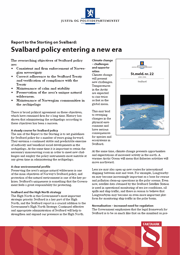Government commitment to Svalbard
Historical archive
Published under: Stoltenberg's 2nd Government
Publisher: Ministry of Justice and the Police
Press release | No: 50 - 2009 | Date: 22/04/2009
The Government will preserve Svalbard’s unique natural wilderness and develop the archipelago as a platform for climate research. At the same time, the Government will continue to develop a robust family community in Longyearbyen, continue coal mining and further develop tourism within the framework of strict environmental standards. These are some of the main points of Report No. 22 (2008-2009) to the Storting, Svalbard.
 | |
|
Download a fact sheet on the Report to the Storting here (pdf). |
The Government will preserve Svalbard’s unique natural wilderness and develop the archipelago as a platform for climate research. At the same time, the Government will continue to develop a robust family community in Longyearbyen, continue coal mining and further develop tourism within the framework of strict environmental standards. These are some of the main points of Report No. 22 (2008-2009) to the Storting, Svalbard.
Steady course. According to the Report to the Storting on Svalbard, the administration of the archipelago is to be clear, predictable and consistent. Norway’s Svalbard policy has been a success, and has enjoyed broad political support over time. During the past decade Longyearbyen has become a modern, family community, while authorities have managed to preserve the archipelago’s unique natural wilderness.
“The Government views the High North as its most important strategic priority area. Svalbard is a key part of this priority. Continued effective and proper Norwegian administration of Svalbard will help to strengthen and expand our presence in the High North”, Knut Storberget, the Minister of Justice.
Clear environmental profile. According to the report, preservation of Svalbard’s unique natural wilderness and protection of its natural environment will continue to be one of the main objectives of Norway’s Svalbard policy.
“Svalbard has unique qualities that the Government feels a special responsibility for preserving”, Storberget said.
Continued coal mining. Coal mining operations will continue to be important for maintaining today’s Longyearbyen community.
“The Government will continue coal mining operations under the strict environmental standards that apply, and within the framework of commercial and safety considerations”, Storberget said.
Longyearbyen is to be developed further as a robust family community with an ample array of services. The Government will continue to apply the principle that Longyearbyen is not to be a “cradle-to-grave” community. At the same time, Longyearbyen is becoming increasingly like communities on the mainland, which is why the Government is sending the signal that more acts of law will be made to apply to Svalbard.
Focus on research. A substantial investment has been made in heavy research infrastructure in Svalbard, particularly in the past decade. The Government will continue to strengthen Svalbard as a platform for Norwegian and international environmental and climate research. Climate change is first seen and is most visible in the Arctic, which is why Svalbard is called the thermometer for climate change.
“Svalbard will become increasingly important as a source of knowledge about climate processes and the impacts of climate change. This is also a key part of Norway’s High North strategy – for us to be at the forefront internationally with regard of developing knowledge about, and in, the High North”, Storberget said.
Tourism and other industry
It is also important to develop other activities as the basis for a robust Longyearbyen community, such as tourism, space exploration and other varied business activities. This development must take place within the framework of strict environmental objectives.
Climate change. Climate change will result in a number of challenges in Svalbard. For example, fauna and their habitats can be directly impacted when vulnerable areas become more easily accessible to traffic. At the same time, climate change will create opportunities, as there will be less sea ice and warmer oceans, and fisheries will move northward.
“Climate change can result in higher ship traffic and greater activity in the area in general. This will boost Longyearbyen’s importance as a base for local rescue and pollution clean-up operations”, Storberget said.
Traffic in Svalbard. Traffic in the form of ship traffic, tourism and research activity is increasing. This will lead to a risk of greater stress on Svalbard’s natural environment. That is why it is necessary to control traffic. To be able to select the most effective means it is important for the Government to continue its effort to enhance our knowledge of how traffic impacts the environment. The Government will consider a number of measures, including amending the environmental protection regulations and formulate management plans for various areas. The work to improve marine safety in the area of Svalbard will continue.